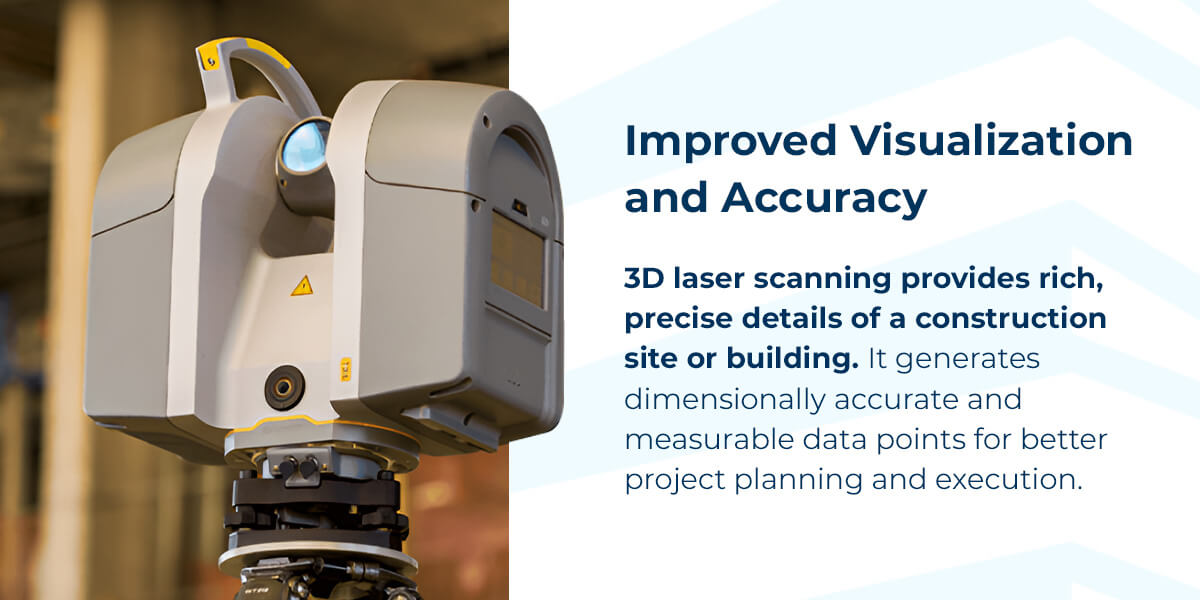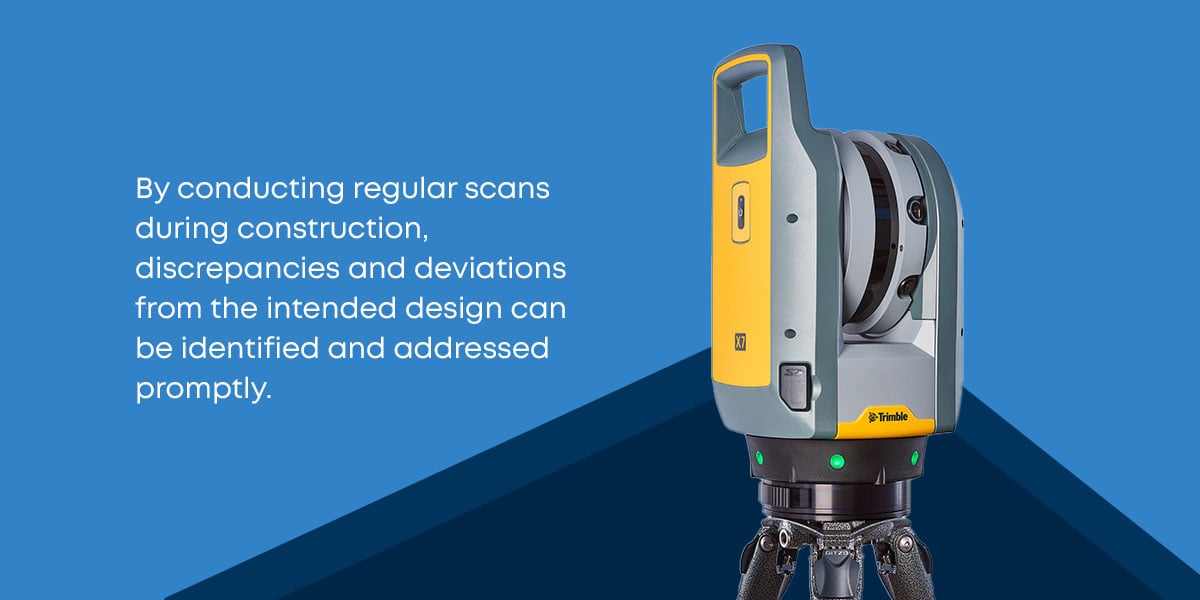Laser scanning is becoming more popular in the construction industry, offering an effective and precise approach to evaluating infrastructure. This approach can help minimize rework, eliminate unnecessary processes and streamline project timelines with accessibility and accuracy.
Laser scanning can help construction teams catch errors that would otherwise need rework and can enhance the management, design and renovation phases. Here, you can learn more about laser scanners in the construction industry, including the best ones to use for your projects and how you can leverage this technology to transform your business.
What is Laser Scanning in the Construction Industry?
The laser scanning process captures, maps and displays the geometry of current infrastructure and existing conditions. You can save, process and upload this scan with the appropriate coordinates to import the data into modeling software. This process provides highly accurate positional information on all building assets that you can use to improve project designs for upkeep and new construction.
Laser scanning is more cost-effective, faster and more precise than traditional survey measurements, empowering construction companies to work more efficiently. You can use laser scanning to aid in several processes, including:
.jpg?width=974&height=487&name=pasted%20image%200%20(1).jpg)
- Minimize errors in design: This technology provides an excellent foundation for design phases, especially for renovations or additions. You can use laser scanners to control your processes early, gathering information quickly and applying it to your project. Using scanners can minimize errors, preventing construction teams from creating flaws they would need to address later in the construction process. Additionally, preventing these errors can reduce the need for change orders, high spending or delays associated with fixing those issues.
- Construction communication: Laser scanning can benefit construction coordination by preventing conflicts between existing electrical, plumbing, HVAC and similar systems. You can also leverage this technology to document project milestones such as wall/ceiling close-in, delegate work and reduce change orders. In the building industry, laser scanning can also help you quickly identify and address existing problems and make it easy to document any mistakes by comparing work in place to the designed conditions.
- Renovations and retrofit: 3D scanners can produce as-built records that facility managers and owners can use to guide repairs, maintenance, demolitions and extensions. If implemented properly, this technology can accurately locate items above the ceiling and inside walls, allowing architects and other teams to use it for easier renovations.
At BuildPoint SouthEast, you can find superior technology, best-in-class service and support to help you navigate your construction projects. We leverage the latest technology, including laser scanners, to help construction businesses excel by increasing accuracy, improving safety and creating efficient layouts. Our 3D scanning solutions simplify complex projects, allowing you to keep moving forward.
Understanding 3D Laser Scanning Basics
Laser scanners can have a significant impact on construction teams. Understanding this technology is crucial for streamlining your processes and selecting the right equipment to meet your needs. Learn more about this technology and how you can leverage it.
What are 3D Laser Scanners?
3D laser scanners are devices that direct laser beams to specific regions with a mirror. The device disperses the laser at precise angles and reflects it to the scanner. This equipment lets users quickly capture geospatially relevant information on a construction project. 3D scanning is a non-destructive way to obtain measurements, and you can rely on this technique for tight spaces as well. You can capture a point cloud of data and turn it into a 3D model, which you can use to design or coordinate the construction process.
What are the Benefits of 3D Scanning in Construction?
From saving time and money to driving better team decision-making, 3D laser scanning can offer numerous benefits for your operations. Here are the advantages of implementing 3D scanning technology in your construction workflow.
1. Improved Visualization and Accuracy

3D laser scanning provides rich, precise details of a construction site or building. It generates dimensionally accurate and measurable data points for better project planning and execution.
Since this technology can capture whole buildings, you can usually obtain all the necessary measurements without any data gaps in your documentation. As a result, your team can expedite material ordering, fabricating and other tasks.
2. Reduced Time and Costs
Laser scanning technology is significantly faster than traditional project mapping techniques, like photography and manual measurements. Aside from being tedious, manual labor can be risky as it's prone to human error. Errors in the construction industry can throw a wrench in your workflow, causing you to lose anywhere from 10%-25% of your overall project costs.
With 3D laser scanning, you can scan an entire project site in minutes — unlike conventional methods that can take hours, days or even weeks. You can attain the exact details you need the first time and ensure a high degree of accuracy.
Your team can minimize project revisits, order changes and other delays that stifle productivity. This is especially critical for high-priority projects. Laser scanning promotes fast and seamless data collection, accelerating project timelines.
Cutting down completion times also benefits your budget. You don't have to devote extra spending to additional materials and labor costs associated with reworks. Should a project require rework, 3D laser scanning can decrease material and labor costs since the scans display precise locations for building elements. You can skip the hassle and expense of digging up slabs and tearing down walls.
3. Enhanced Collaboration
Laser scanning streamlines coordination among your entire team, as everyone can access the scans virtually. Even when stakeholders, surveyors and clients cannot travel to the physical site, they can use the cloud data points to gauge the space's dimensions and take measurements. Additionally, contractors can use building models to work remotely and respond to information requests.
Your whole crew can access the same information, ensuring no one is left in the dark. By improving communication across the board, 3D laser cutting can encourage faster and more practical decision-making. Better collaboration, in turn, can:
- Increase productivity and reduce project completion times.
- Cultivate team relationships.
- Foster a more dynamic work environment overall.
4. Increased Safety
A variety of factors can contribute to accidents during construction projects, such as:
- Falling off elevated work surfaces or equipment.
- Being struck by falling debris and objects.
- Getting caught between trenches or heavy materials.
- Performing repetitive straining motions, like bending, twisting and turning.
- Being involved in accidents with power tools, vehicles, cranes or other heavy equipment.
- Being exposed to toxic chemicals, electrocutions, fires or explosions.
Unfortunately, a lot of these incidents can be severe or even fatal. Many can stem from working in unfavorable conditions, like temperature or weather extremes and limited space.
Three-dimensional laser scanners sit on a tripod, gathering data from a distance in hazardous or tough-to-reach locations. This technology reduces the need for employees to maneuver in these conditions, helping keep them out of harm's way. You can measure elements and spaces from the comfort of your computer rather than in a potentially dangerous work environment.
You don't have to climb up a ladder to measure a ceiling joist or squeeze into a tight space to acquire a measurement. Simply click and drag between points. Besides providing a more secure data collection method, 3D laser scans are likely to produce more accurate measurements than manual ones.
Additionally, the laser scanner is noninvasive, so it won't disrupt or damage historic sites and artifacts. The same can't necessarily be said for large, intrusive tools and equipment.
Utilizing 3D Laser Scanning for Construction
The adoption of 3D laser scanning has led to numerous applications that are transforming traditional construction processes:
Building Information Modeling (BIM)
3D laser scanning plays a pivotal role in creating accurate and detailed as-built models for BIM. By capturing precise measurements of existing structures and environments, laser scanning provides the foundation for developing a comprehensive digital representation of a building or infrastructure project.
The integration of 3D laser scanning with BIM brings numerous benefits to the construction industry. It allows for clash detection and clash prevention during the design phase, reducing conflicts and rework during construction. Additionally, it facilitates accurate quantity takeoffs, material estimations and spatial analysis, leading to improved project planning and cost control.
Pre-Construction and Site Analysis
By capturing precise measurements of existing structures, laser scanning helps evaluate their condition and structural integrity. It also aids in understanding site topography, allowing architects and engineers to design projects that fit harmoniously within their surroundings.
Quality Control and Progress Monitoring

Laser scanning enables precise comparisons between as-built conditions and design plans. Regular scans during construction help identify discrepancies, ensuring the project aligns with the intended design. Furthermore, it allows project managers to track progress over time, enhancing communication and facilitating timely project completion.
Facility Management and Maintenance
3D laser scanning produces detailed as-built documentation, which is invaluable for facility management. This documentation simplifies future renovations and repairs, minimizing manual measurements and errors. Additionally, it helps visualize complex building systems for effective maintenance planning.
Best 3D Laser Scanners for Construction
Choosing the best laser scanner involves understanding your project needs and what each device can accomplish. Consider factors like device accuracy, resolution, data visualization, cost and versatility. You can find many types of scanner configurations, features, printing variations and other crucial elements, making it essential to evaluate what you need and what your device can accomplish.
The Trimble X9
The Trimble X9 is our top choice for laser scanning in construction because it's fast, easy to use, and reliable. It helps you capture accurate measurements quickly, making your job easier and more efficient.
Here's why we love it:
- Fast and efficient: Scans up to 1 million points per second, so you spend less time scanning and get more detailed data
- Easy to use: Works with simple software that helps you manage and check your projects on the go. You can control it with a tablet, phone, or just one button
- Reliable: It auto-calibrates and self-levels to ensure precise measurements every time. Built to handle tough conditions with an IP55 rating and a wide temperature range
- Portable: Lightweight and comes with a backpack for easy carrying around the site
With the Trimble X9, you'll get accurate, high-quality data quickly, making it perfect for any construction project.
If you need assistance integrating laser scanning technology, rely on the professionals. BuildingPoint SouthEast has years of experience in the industry, and our technology makes us the partner you need for these applications. Connect with our team for help selecting the suitable model for your project needs.
Get Started With 3D Laser Scanning For Construction
In summary, laser scanning enhances construction by increasing accuracy, improving safety, and reducing project costs. When you need reliable and fast data collection, laser scanning is the best solution. These devices can provide valuable insights that guide decision-making and aid throughout project life cycles.
With BuildingPoint SouthEast, you can find the innovative technology you need to take construction projects to the next level. Our solutions offer a wide range of features to streamline processes and deliver increased accuracy and quality. Using our technology, you can transform your processes and enhance your business. Ready to get started with the best laser scanner and technology solutions? Request a quote to see what our solutions can do for you.






